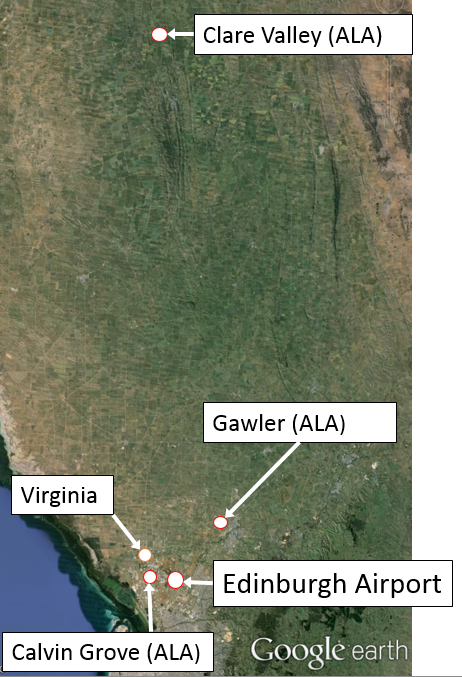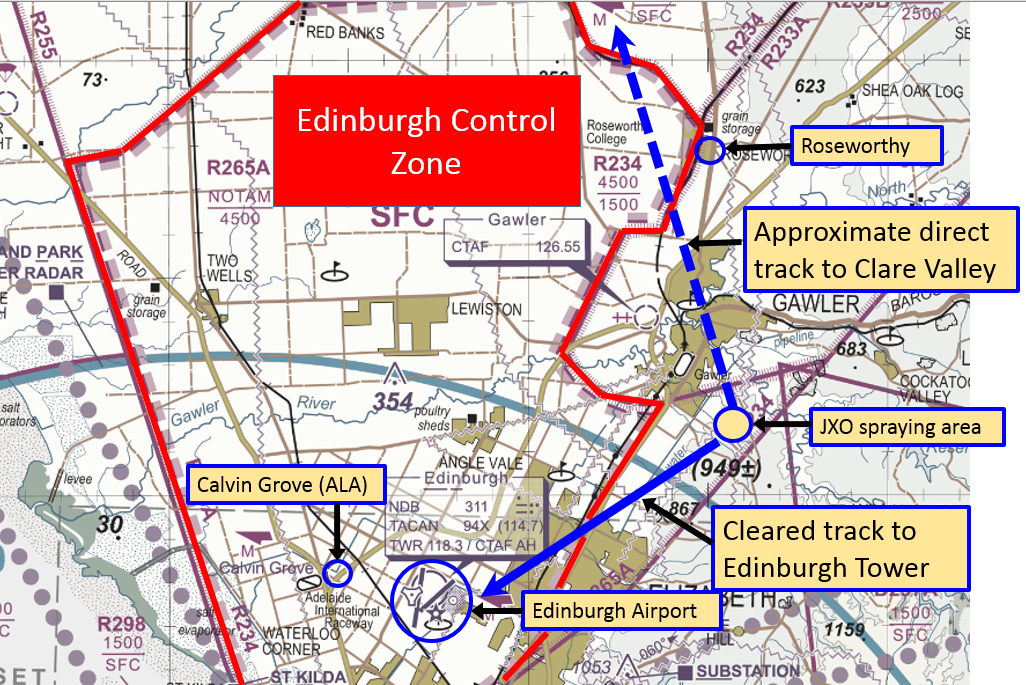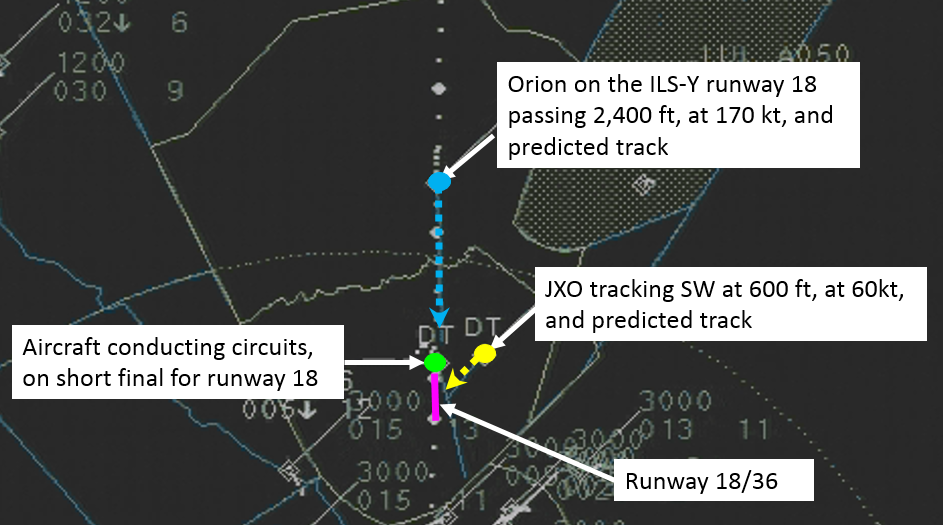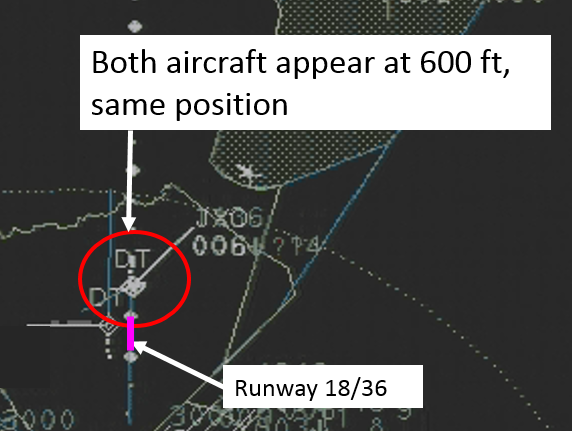What happened
On 31 August 2015, the pilot, and sole occupant, of a Schweizer 269C helicopter, registered VHJXO (JXO), was conducting aerial spraying in the Edinburgh area, South Australia, and operating under the visual flight rules (VFR). The helicopter departed from Calvin Grove aeroplane landing area (ALA) at about midday Central Standard Time (CST), and the pilot obtained a clearance from Edinburgh Airport air traffic control (ATC) to track to Virginia (Figure 1). The pilot conducted spraying operations in that area, and then requested and obtained a clearance to track to an area south of Gawler. The operations included regular take-offs and landings to refuel and reload with chemical. The pilot continued spraying operations about 3.5 NM southeast of Gawler aeroplane landing area (ALA), which was outside the Edinburgh control zone, below the 1,500 ft lower limit of restricted airspace, and therefore in Class G airspace.
Figure 1: Locations relevant to VH-JXO
Source: Google earth – annotated by the ATSB
At about 1503 CST, a Military Lockheed AP-3C aircraft (Orion) was about 15 NM northeast of Edinburgh, at 6,500 ft, tracking for the runway 18 instrument landing system (ILS) –Y approach to Edinburgh Airport. The Orion, with 5 crewmembers and 14 passengers on board, had departed about 10 hours earlier on an international flight bound for Edinburgh, and was operating under the instrument flight rules (IFR).[1] The weather conditions at Edinburgh at the time, included no cloud below 5,000 ft and visibility greater than 10 km.
At about 1504, the pilot of JXO called Edinburgh Tower air traffic control, and requested a clearance to track to ‘Clare’ (Clare Valley), South Australia. In order to track direct to Clare Valley, which was about 45 NM to the north-northwest, the pilot needed a clearance through a corner of the Edinburgh control zone (Figure 2).
Figure 2: Operating area of JXO, Edinburgh Control Zone and relative tracks
Source: Airservices Australia – annotated by the ATSB
The tower (TWR) controller 1, mistook the pilot’s request to ‘Clare’ for ‘Calvin Grove’, and cleared the pilot of JXO to track direct to Edinburgh Tower, not above 1,000 ft in order to be able to visually separate the helicopter with the arriving Orion and another aircraft conducting circuit operations at the airfield. The pilot complied with the instruction, even though this was not the direction requested, nor the clearance expected. However, being new to the area and concerned about the direction of the clearance, the pilot attempted, unsuccessfully, to contact their company via UHF radio to ask for advice.
At about 1506, the TWR controller 1 completed their shift and conducted a handover to tower (TWR) controller 2. The TWR controller 1 advised TWR controller 2 of JXO, tracking to the tower then for Calvin Grove, and stating that they planned to track JXO ‘over the top’ (of the airfield) to separate with the Orion and could hold JXO if necessary, depending on the requirements of the aircraft conducting circuits. About 2 minutes later, the crew of the Orion reported established on the ILS.
At about 1509, when about 5 NM from the tower, the pilot of JXO reported the helicopter’s position to the tower controller, hoping to prompt the controller for a clearance towards Clare Valley, but the TWR controller 2 directed the pilot to continue tracking direct to the control tower. The pilot then again attempted to contact their company via UHF radio to seek guidance on Edinburgh operations.
About 1 minute later, the TWR controller 2 advised the aircraft conducting circuit operations at Edinburgh of both the Orion, then at 12 miles on the ILS, and JXO, as traffic, stating that JXO was for Calvin Grove. During that transmission, the pilot of JXO was trying to communicate on UHF radio and did not assimilate the information about the Orion. Soon after that transmission, the flight crew of the Orion, which was then at 9 NM, advised they were on the ILS-Y passing 3,200 ft[2] on descent.
The circuit aircraft then turned onto base leg for runway 18, was cleared for a touch-and-go, and advised they had the (Orion) aircraft in sight.
At about 1512, the Orion was passing 2,400 ft, on a 6.5 NM final and travelling at 170 kt. JXO was at 600 ft and travelling at 60 kt (Figure 3). Based on the expected tracking of the three aircraft, the TWR controller 2 assessed that JXO would safely cross the runway centreline in front of the Orion, and behind the aircraft conducting circuits (then on a short final). Consequently, the TWR controller 2 cleared JXO to track to Calvin Grove. The pilot heard the call and responded, but the radio was still selected to transmit on UHF not VHF, so the controller did not receive a response. The pilot was flustered and expecting an onwards clearance to Clare Valley, consequently had turned right to track northwards to Clare Valley.
Figure 3: Aircraft positions when JXO was cleared to Calvin Grove (time 1512)
Source: Department of Defence – annotated by the ATSB
Having not received a response, the TWR controller 2 repeated the call to JXO, and again did not receive a response. The TWR controller 2 then made two more attempts to communicate with the pilot of JXO, including requesting a ‘radio check’, without receiving a response. The pilot of JXO could hear the calls and eventually realised they had the incorrect radio selected to transmit.
Separation Standards
According to the Manual of Air Traffic Services (MATS), separation is the concept of ensuring aircraft maintain a prescribed minimum from another aircraft (or object), while meeting the associated conditions, and requirements of the standard. A separation standard is a prescribed means to ensure separation between aircraft using longitudinal, lateral, vertical and visual standards.
Use of the Situation Data Display
Edinburgh Tower controllers did not hold approach endorsements and therefore were not able to use the radar situation data display (SDD) to vector aircraft to achieve separation. The controllers were required to achieve separation through the issue of tracking instructions, level assignment or through visual observation. The radar SDD could be used to monitor separation and achieve situational awareness.
While attempting to establish communications with JXO, the TWR controller 2 monitored JXO’s tracking using binoculars. About the time of the radio check, JXO appeared to turn right, then fluctuate between north-westerly and westerly headings. Due to the small size of JXO and its distance from the tower, its exact tracking was difficult to determine visually. Furthermore, the tower radar situation data display (SDD) did not provide a true representation of the helicopter’s tracking, due to its slow speed. The SDD did indicate that JXO had tracked further north than cleared, which increased the closure rate between the helicopter and the Orion.
At about 1513, the pilot of the Orion reported at the outer marker on the ILS (4.2 NM from the runway threshold), and the TWR controller 2 cleared the Orion to land (Figure 4). JXO was then tracking north-northwest, about 3 NM from the Orion, and converging. The TWR controller 2 was then apprehensive about JXO’s tracking. Although the crew of the Orion had heard the controller’s attempts to contact JXO, as the controller had not provided them with directed traffic information, they were unaware of JXO’s position, and assumed it was not a consideration for their tracking.
Figure 4: Orion at the outer marker (time 1513)
Source: Department of Defence – annotated by the ATSB
The TWR controller 2 then conducted another radio check with the pilot of JXO in an attempt to re-establish communications. The Orion and JXO were about 1.5 NM apart, and their flight paths were merging. On the radar SDD, JXO was indicating about 700 ft and the Orion was passing 1,100 ft on descent. The TWR controller 2 then conducted another radio check using an alternative handset, to ascertain whether the communications issue may be due to ATC equipment.
The pilot of JXO responded, apologised, advised they had the radio selected to an incorrect frequency, and that they had requested a clearance to track to Clare Valley, not Calvin Grove. During that transmission, the distance between JXO and the Orion reduced to about 1 NM laterally, and 200 ft vertically.
Immediately following the pilot of JXO’s response, the TWR controller 2 asked whether the pilot had the ‘P3’ (Orion) in sight, advising that it was then in the pilot’s 1 o’clock[3] position at about 2 miles. The pilot queried the aircraft type, and the TWR controller 2 advised that the ‘P3 Orion’ was now at about 1 mile in the pilot’s 2 o’clock position. The pilot was initially unable to sight the Orion, as it was below, to the right, and behind the helicopter, and therefore not in the pilot’s 1 or 2 o’clock position (Figure 5). The pilot then saw the Orion’s shadow on the ground and sighted the Orion. The pilot of JXO responded having the aircraft in sight, and the TWR controller 2 directed the pilot to pass behind that aircraft.
Figure 5: Relative positions when ATC advised JXO of the Orion (time 1514)
Source: Department of Defence – annotated by the ATSB
By the time the controller completed that transmission, JXO had passed overhead the Orion. On sighting the Orion, the pilot of JXO had immediately initiated a climb to avoid a collision, and estimated the Orion passed about 100 ft below. On hearing the controller pass the Orion as traffic to the pilot of JXO, the Orion crew immediately became concerned about the helicopter’s proximity, and looked for it. The co-pilot (non-flying pilot) of the Orion sighted JXO, assessed there was a risk of collision, and called ‘go low, go low, go low’. The captain (flying pilot), also sighted JXO, and increased the rate of descent to pass beneath the helicopter. The Orion crew estimated that JXO passed about 50 ft directly above the Orion, and were concerned it may collide with the Orion’s vertical tail fin. On the radar SDD, at 1514:25, both aircraft appear in the same position at 600 ft (Figure 6).
Figure 6: Aircraft collocated on radar SDD
Source: Department of Defence – annotated by the ATSB
The Orion landed without further incident on runway 18. The pilot of JXO was subsequently cleared to depart the Edinburgh control zone tracking to Clare Valley.
Pilot comments
The pilot of JXO provided the following comments:
- The pilot could have tracked around the restricted airspace towards Clare Valley, by going via Roseworthy. The pilot was new to the area, unsure of the local landmarks, and therefore requested a clearance to track direct.
- The pilot was nervous about operating in military controlled airspace and therefore did not question the clearance to track towards the Tower, even though it was not where they wanted to go. The pilot reported feeling ‘a bit rattled’.
- The pilot had selected Clare Valley on the GPS, and was unsure exactly where Calvin Grove was from their current position. If JXO had tracked to Calvin Grove, it would have remained clear of the aircraft approaching runway 18.
Department of Defence investigation
The Department of Defence conducted an investigation and made a number of findings. Some of those findings are detailed here.
Initial airways clearance issued to JXO
The TWR controller 1 interpreted JXO’s destination as Calvin Grove. Two hours prior to the incident, the TWR controller 1 had processed JXO from Calvin Grove, thereby associating JXO with Calvin Grove. Additionally, JXO could have tracked from their location near Gawler to Clare, with only a small deviation east of Roseworthy to remain clear of the restricted airspace (see Figure 1). Therefore, the controller would not have expected a request of an airways clearance to Clare from JXO.
Communications issue
The TWR controller 2 made six attempts to re-establish two-way communications with the pilot of JXO over a period of 92 seconds. The loss of two-way communications was due to the pilot transmitting on an alternative frequency.
The loss of two-way communications with JXO meant that the TWR controller 2 was unable to pass instructions to the pilot to sight, and maintain separation with, the Orion. The attempts of the pilot of JXO to communicate with their company on UHF radio also diminished the pilot’s ability to maintain situational awareness of other traffic within the control zone from the radio calls of the circuit aircraft, the Orion crew, and the controller.
The combination of communication difficulties and clearance towards an incorrect destination, led to the pilot of JXO becoming flustered. The pilot therefore turned towards Clare instead of the cleared destination of Calvin Grove. Shortly before returning to Tower frequency, the pilot realised the last clearance issued was to Calvin Grove, and turned onto a westerly heading, thereby converging with the Orion.
Visual separation
Visual separation (MATS)Separation may be reduced in the vicinity of aerodromes when adequate separation can be provided using visual observation and each aircraft is continuously visible to the aerodrome controller.
Visual separation (MATS)
Separation may be reduced in the vicinity of aerodromes when adequate separation can be provided using visual observation and each aircraft is continuously visible to the aerodrome controller.
The TWR controller 2 assessed that sufficient time and distance existed for JXO (tracking for Calvin Grove) to cross final ahead of the Orion while maintaining the visual separation standard. However, the disparate sizes and speeds of the Orion and JXO, combined with their relative positions and distance from the control tower, made it difficult to maintain separation by visual observation.
After the Orion crew reported at the outer marker, it became apparent to the controller that visual separation would be lost. However, due to the proximity and relative tracks of the helicopter and the Orion, it was then impossible to introduce an alternative separation standard such as vertical displacement[4] or assigning separation responsibility to the pilot.
Compromised separation recovery
In accordance with the Manual of Air Traffic Services (MATS), the Orion had a higher priority because it was operating under IFR flight rules. This influenced the TWR controller 2’s decision to allow the Orion to continue the ILS-Y approach, while attempting to communicate with JXO. However, MATS also required controllers not to compromise safety in order to meet the priorities.
The TWR controller 2 did not pass traffic information on JXO to the crew of the Orion, as the controller did not intend to assign responsibility for separation to them. The controller intended for the pilot of JXO to sight the Orion and accept responsibility for separation. Passing traffic information to the smaller aircraft on the larger aircraft conformed to the compromised separation recovery techniques taught to the controller.
The combination of incorrect application of visual separation, ATC priorities, and the decision not to amend the Orion’s tracking, led to a loss of separation between the Orion and JXO, including a loss of wake turbulence separation.
The TWR controller 2 assessed that instructing the Orion to go around from the approach would not solve the confliction, as the aircraft may not achieve sufficient climb performance to overfly JXO. The controller also assessed that the Orion crew may not safely have been able to conduct a hard right turn as the aircraft was in the landing configuration and at a critical stage of flight. The Orion flight crew later advised that a right turn manoeuvre to avoid the confliction would have been within the capabilities of the aircraft.
The TWR controller 2 did not issue a safety alert. The controller reported that they were about to issue a safety alert to the Orion crew, when the pilot of JXO returned to the Tower frequency, and made a transmission that lasted 10 seconds. At that time, the aircraft were 1.2 NM apart laterally, and 400 ft vertically. A safety alert issued at that time may have allowed the Orion crew to increase the vertical separation between the aircraft. If the controller had issued a safety alert earlier, it would have increased both lateral and vertical distances between them.
The clock positions provided to the pilot of JXO were incorrect and delayed the pilot’s ability to sight the Orion. The preferred compromised separation recovery technique is to provide a bearing and distance of the other aircraft to the pilot, which was available from the radar SDD.
Traffic collision avoidance system
The Orion is fitted with a traffic collision avoidance system (TCAS). In accordance with standard operating procedures, the crew of the Orion had selected low sensitivity mode on the TCAS when established on the ILS, and prior to contacting Edinburgh Tower. This mode provides no audible alert to the aircrew of potentially conflicting traffic. The captain and the co-pilot both observed the circuit aircraft on the TCAS display indicating that the system was functioning normally, but JXO did not appear. While JXO had a functioning transponder, the reason that it was not being displayed on the Orion’s TCAS could not be determined.
Safety action
Whether or not the ATSB identifies safety issues in the course of an investigation, relevant organisations may proactively initiate safety action in order to reduce their safety risk. The ATSB has been advised of the following proactive safety action in response to this occurrence.
Department of Defence
As a result of this occurrence, the Department of Defence advised the ATSB that they are taking a number of safety actions. These include the following:
Compromised separation recovery training
The Department of Defence has released a Standing Instruction that mandates annual compromised separation recovery training for all air traffic controllers.
Controller briefing
All controllers will be briefed on the events and findings of the incident as an element of compromised separation recovery training.
Tower simulation capability
Tower simulation capability is being introduced to enhance compromised separation recovery training.
Additionally, simulation will be used to:
- compensate for low traffic levels and to facilitate controller attainment and retention of skills associated with processing complex traffic scenarios
- compensate for low traffic levels and to facilitate controller attainment and retention of skills associated with application of ATC priorities
- assess controller proficiency when live traffic levels are below that required to judge controllers’ abilities to process complex traffic scenarios
- provide controllers with regular exposure to compromised separation recovery scenarios, to improve decision making and ensure the associated actions become instinctive.
Airspace procedure briefings
The Edinburgh controllers will provide airspace procedure briefings to pilots who conduct airwork within and around Edinburgh airspace. The Airservices Australia Aeronautical Information Publication (AIP) En Route Supplement Australia (ERSA) entry for Edinburgh will be amended to include a section detailing the requirements for pilots of civil aircraft intending to conduct airwork within, or near, the Edinburgh control zone, to have airspace briefing.
Safety message
This incident highlights the importance of communication, and demonstrates the potential consequences of a loss of communication. Whether pilots are communicating with each other, or with air traffic control, it is essential to understand what is being said and how that potentially affects them. In particular, if an instruction from air traffic control is not as expected, pilots should request clarification.
For controllers, having tactical separation assurance in place reduces the likelihood of a loss of separation, particularly in the event of communications failure.
Compromised separation recovery is a critical skill for air traffic controllers, which needs to be practiced often and in sufficiently complex scenarios to be applicable and implemented when necessary.
The Australian Transport Safety Bureau (ATSB) research report AR-2012-034 titled Loss of separation between aircraft in Australian airspace January 2008 to June 2012 found that aircraft separation is a complex operation with many levels of defences to avoid errors and safely manage the results of errors made by air traffic controllers and pilots.
Aviation Short Investigations Bulletin - Issue 45
Purpose of safety investigationsThe objective of a safety investigation is to enhance transport safety. This is done through:
It is not a function of the ATSB to apportion blame or provide a means for determining liability. At the same time, an investigation report must include factual material of sufficient weight to support the analysis and findings. At all times the ATSB endeavours to balance the use of material that could imply adverse comment with the need to properly explain what happened, and why, in a fair and unbiased manner. The ATSB does not investigate for the purpose of taking administrative, regulatory or criminal action. TerminologyAn explanation of terminology used in ATSB investigation reports is available here. This includes terms such as occurrence, contributing factor, other factor that increased risk, and safety issue. Publishing informationReleased in accordance with section 25 of the Transport Safety Investigation Act 2003 Published by: Australian Transport Safety Bureau © Commonwealth of Australia 2015
Ownership of intellectual property rights in this publication Unless otherwise noted, copyright (and any other intellectual property rights, if any) in this report publication is owned by the Commonwealth of Australia. Creative Commons licence With the exception of the Coat of Arms, ATSB logo, and photos and graphics in which a third party holds copyright, this publication is licensed under a Creative Commons Attribution 3.0 Australia licence. Creative Commons Attribution 3.0 Australia Licence is a standard form licence agreement that allows you to copy, distribute, transmit and adapt this publication provided that you attribute the work. The ATSB’s preference is that you attribute this publication (and any material sourced from it) using the following wording: Source: Australian Transport Safety Bureau Copyright in material obtained from other agencies, private individuals or organisations, belongs to those agencies, individuals or organisations. Where you wish to use their material, you will need to contact them directly. |
__________
- In accordance with the Manual of Air Traffic Services (MATS) para. 2.4.2.2, air traffic control is responsible for providing separation between IFR and VFR aircraft.
- All altitudes in the report are in feet above mean sea level (AMSL). Edinburgh Airport elevation is 67 ft AMSL. The radar display shows altitude to the nearest 100 ft.
- The clock code is used to denote the direction of an aircraft or surface feature relative to the current heading of the observer’s aircraft, expressed in terms of position on an analogue clock face. Twelve o’clock is ahead while an aircraft observed abeam to the left would be said to be at 9 o’clock.
- The minimum vertical separation required at that time, would have been 1,000 ft.








